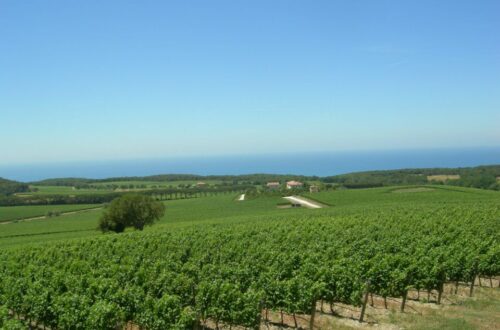Bardolino DOC is a light, ruby-red wine from the shores of Lake Garda in Veneto, Italy. Made primarily from the Corvina and Rondinella grapes, it produces fresh, approachable reds as well as the elegant Chiaretto rosé. Recognized as a DOC in 1968 and with Superiore DOCG status since 2001, Bardolino is celebrated for its versatility, food-friendliness, and breezy charm.
Table of Contents
What is Bardolino DOC?
Bardolino DOC refers to a family of wines produced on the eastern shores of Lake Garda, one of Italy’s most enchanting wine regions. Known for their light body, vibrant acidity, and ruby hue, Bardolino wines are often compared to Beaujolais for their easy-drinking style. Beyond the reds, Bardolino also includes Chiaretto rosé, a stylish pale pink wine now enjoying global acclaim.
Pronunciation: Bar-doh-LEE-noh
History and Origins
Winegrowing around Bardolino traces back to Roman times, when vineyards thrived along the shores of Lake Garda. The name “Bardolino” likely derives from “bardus,” meaning a small hamlet or village, hinting at its deep local roots.
The DOC was officially established in 1968, making Bardolino one of Veneto’s earliest recognized appellations. In 2001, Bardolino Superiore gained DOCG status, affirming its place among Italy’s highest-quality wines.
Geography & Terroir
The Bardolino zone stretches across rolling hills between Verona and Lake Garda, where the lake’s moderating effect creates a mild, Mediterranean-like climate. Soils are a mosaic of glacial moraine, gravel, and limestone—perfect for producing fresh, fragrant reds and crisp rosés.
Nearby attractions include Gardaland theme park, Lazise’s medieval walls, and the charming town of Bardolino itself, which hosts an annual wine festival each October.
Grape Varieties & Blends
Bardolino wines are typically blends, with the Corvina grape taking the starring role:
- Corvina (35–95%) – Provides bright cherry fruit, structure, and acidity
- Rondinella (10–40%) – Adds floral and herbal notes
- Molinara (up to 15%) – Once traditional, now optional, lending freshness
- Small amounts of Merlot, Cabernet, or other local grapes may be included
This makes Bardolino a close cousin to Valpolicella, though lighter and fresher in style.
Wine Styles & DOC Regulations
Bardolino Classico DOC
Produced in the historic heartland, known for delicate red fruit and lively freshness.
Bardolino Superiore DOCG
Aged for at least one year, offering more body, structure, and spice.
Bardolino Chiaretto
A pale, Provençal-style rosé with wild strawberry, citrus zest, and floral tones—perfect for summer sipping.
Bardolino Novello
An early-released red, made in a Beaujolais Nouveau style, bursting with youthful fruit.
Key Facts at a Glance
| Category | Details |
| Region | Veneto, Italy (Lake Garda) |
| DOC Established | 1968 |
| Superiore DOCG | 2001 |
| Primary Grapes | Corvina, Rondinella |
| Styles | Red, Chiaretto rosé, Superiore DOCG, Novello |
| Average Alcohol | 11–13% |
| Vineyard Area | ~2,700 ha |
| Annual Production | ~15 million bottles |
| Serving Temp | 14–16°C (reds), 10–12°C (Chiaretto) |
Tasting Notes & Characteristics
- Bardolino DOC Reds: Light ruby color, aromas of cherry, raspberry, violets, with a soft, dry palate.
- Bardolino Superiore DOCG: Deeper ruby, notes of black cherry, pepper, and spice, with more structure and age-worthiness.
- Chiaretto Rosé: Pale pink, bright citrus, wild strawberry, and subtle floral tones.
- Novello: Fresh, fruity, youthful—best enjoyed immediately.
Food Pairing & Serving Tips
Bardolino wines shine with everyday Italian cuisine.
- Bardolino DOC Reds: Pair with pizza Margherita, pasta with tomato sauce, grilled chicken, charcuterie.
- Bardolino Superiore DOCG: Match with roasted meats, risotto all’Amarone, or aged cheeses.
- Chiaretto Rosé: Perfect with seafood, sushi, summer salads, or aperitivo.
- Novello: Enjoy with antipasti, young cheeses, or chestnut dishes during autumn.
Glassware tip: Use a tulip-shaped glass to capture Bardolino’s delicate aromas.
Where to Buy & Pricing
- Entry-level Bardolino DOC reds: $10–15
- Chiaretto rosé: $12–18
- Bardolino Superiore DOCG: $20–35
- Top producers & premium selections: $40+
Shop Bardolino wines through Wine.com, Vivino, or at Italian specialty importers.
Top Bardolino Producers
- Guerrieri Rizzardi
- Cavalchina
- Zenato
- Le Fraghe (renowned for organic Chiaretto)
- Marchesini Family Estate
Vintage Guide
- Recent standouts: 2018, 2019, 2021 (fresh, balanced)
- Superiore DOCG: Best aged 3–5 years, though top vintages can cellar up to 8–10.
Bardolino vs. Valpolicella
| Feature | Bardolino | Valpolicella |
| Body | Light, delicate | Medium, more structure |
| Key Style | Fresh reds + Chiaretto rosé | Amarone, Ripasso, fuller reds |
| Price Range | Affordable | Wider spectrum, can be premium |
| Best For | Casual dining, summer | Rich meals, cellaring |
Frequently Asked Questions
Is Bardolino wine sweet or dry?
Bardolino wines are typically dry, though light and fruit-forward.
What makes Bardolino different from Chianti?
Chianti is fuller, spicier, and Sangiovese-based, while Bardolino is lighter and Corvina-based.
When should I drink Bardolino wine?
Enjoy Bardolino DOC and Chiaretto young (within 2–3 years). Superiore DOCG can age up to 10 years.
Fun Facts & Cultural Notes
- The Bardolino Wine Festival each October celebrates the harvest with tastings, music, and fireworks.
- Bardolino Chiaretto has become Italy’s answer to Provence rosé, with soaring exports.
- Lake Garda’s breezes, known as the Ora del Garda, play a vital role in ripening grapes.
CTA for Audience Engagement:
👉 Planning a Lake Garda trip? Try Bardolino at its source—subscribe to our newsletter for insider wine routes, tastings, and Italian travel tips.


